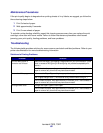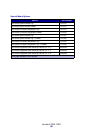
Lexmark T520, T522
64
• Do not use card stock that is creased. It may cause paper jams.
Grain Direction
Grain refers to the alignment of the paper fibers in a sheet of paper. Grain is either grain long,
running the length of the paper, or grain short, running the width of the paper.
For 60 to 135 g/m
2
(16 to 36 lb bond) paper, we recommend grain long stock. For papers heavier
than 135 g/m
2
(36 lb bond), grain short is preferred. For the multipurpose feeder, we recommend
60 to 135 g/m
2
(16 to 36 lb bond) paper, grain long. If you feed papers heavier than 135 g/m
2
(36 lb
bond) from the multipurpose feeder, grain short is preferred.
Print Material Specifications
Print Material
Range or Maximum Weight Supported
Integrated Tray and Optional
500-Sheet Drawer
Multipurpose Feeder
3
and
Optional 250-Sheet Drawer
Paper
(Grain direction
1
)
Xerographic or
business paper
60 to 176 g/m
2
(16 to 47 lb bond)
60 to 135 g/m
2
(16 to 36 lb bond)
Card Stock
(Grain direction
1
)
Index Bristol
199 g/m
2
(110 lb) 163 g/m
2
(90 lb)
Tag
203 g/m
2
(125 lb) 163 g/m
2
(100 lb)
Cover
216 g/m
2
(80 lb) 176 g/m
2
(65 lb)
Labels Paper
180 g/m
2
(48 lb bond) 163 g/m
2
(43 lb bond)
Dual-Web Paper
180 g/m
2
(48 lb bond) 163 g/m
2
(43 lb bond)
Vinyl
300 g/m
2
(92 lb liner) 260 g/m
2
(78 lb liner)
Polyester
220 g/m
2
(59 lb bond) 220 g/m
2
(59 lb bond)
Integrated Forms Pressure
Sensitive Area
2
140 to 175 g/m
2
140 to 175 g/m
2
Paper Base
(Grain Long)
75 to 135 g/m
2
(20 to 36 lb bond)
75 to 135 g/m
2
(20 to 36 lb bond)
1
See “Grain Direction” on page 64 for specific recommendations.
2
Pressure sensitive area must enter the printer first for grain short paper.
3
Due to label design characteristics, unacceptable feeding may be experienced from the multipurpose
feeder.


















